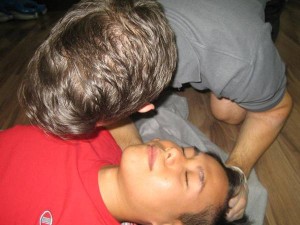Most car manufacturers make sure that their vehicle models are able to withstand impact in case of car crashes to protect drivers and passengers. Airbags, seat belts, collapsible steering wheels, auto-brake mechanism, roll bars, ‘crumple zones’ – all of these and other similar devices are designed to ensure safety in the event of a road mishap. Unfortunately, not all vehicle models on the Canadian roads are equipped with these modern safety features, and many provide poor or no protection at all.
In Canada, thousands of road accidents occur every year. As a trained first aider, it is not uncommon to encounter road accident. In case you find yourself in such situation, stay calm and methodical with your actions. First aiders are expected to provide leadership, support and guidance, not just for the victims, but for all the bystanders within the scene of accident.
Work in a systematic way in providing first aid for the victim.
Assess the scene
Quickly assess the scene of accident. Here are some questions to guide you with your initial observations or assessments:
- What is the nature of emergency?
- How many victims/casualties?
- What injuries were sustained?
- Are they conscious or unconscious, coherent or incoherent?
- Any victim with serious/life-threatening injury?
- Are there any trapped or immobile victims?
After doing your initial survey, call for help or ask someone to do so. Provide important information such as the exact location of the accident, number of casualties, types of injuries sustained, projected seriousness of injuries, and if rescue efforts for trapped victims is necessary.
Organize bystanders
Most of the time, road accidents are crowd-drawers, unfortunately instead of doing good for the victim, bystanders can cause further harm. It is important that you manage the crowd for a successful first aid. You can ask assistance from bystanders, such as by asking:
- Are there any trained first aiders here?
- Could someone give me a hand?
- Did anyone see what happened?
However, organizing the crowd should not delay providing first aid. You will also need to prioritize the casualties – also called triage – depending on who will benefit most from first aid. For example, a casualty who is bleeding profusely requires immediate care more than a person who is walking with minor wounds.
If there is no adequate help available, do not initiate or commit into resuscitating a cardiac arrest victim while ‘sacrificing’ others who need urgent medical help.
Treatment of casualties
Make sure you provide treatment in accordance with what you learned in your first aid training course. DO NOT attempt to move a seriously injured victim out of a vehicle unless there is immediate danger such as potential fire or explosion, airway protection, fear of further collision, control of severe bleeding, or when CPR is necessary.
While waiting for emergency services to arrive, provide any possible treatment and reassurance that you can. Be ingenious by using whatever materials are available to you. Make sure to keep victims warm. Although ‘walking wounded’ casualties do not often need urgent care, be sure to periodically check on them. Monitor for signs of shock and be ready to provide treatment. At the arrival of the ambulance, provide helpful information to the emergency personnel, especially about the treatment you have provided.

